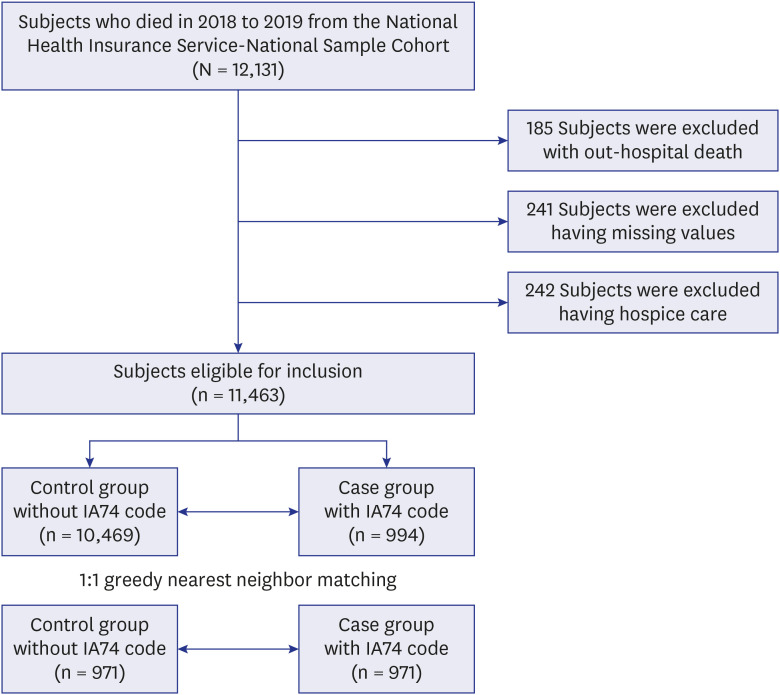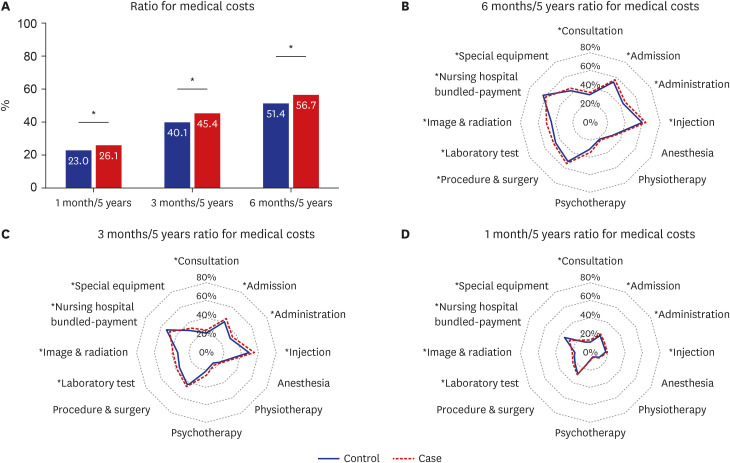J Korean Med Sci.
2024 Feb;39(6):e73. 10.3346/jkms.2024.39.e73.
The Impact of Withdrawing or Withholding of Life-Sustaining Treatment: A Nationwide Case-Control Study Based on Medical Cost Analysis
- Affiliations
-
- 1Department of Medical Humanities, Dong-A University College of Medicine, Busan, Korea
- 2Department of Optometry, Eulji University, Seongnam, Korea
- 3Department of Physiology, Dong-A University College of Medicine, Busan, Korea
- KMID: 2553310
- DOI: http://doi.org/10.3346/jkms.2024.39.e73
Abstract
- This study measured the impact of the Decisions on Life-Sustaining Treatment Act by analyzing medical cost data from the National Health Insurance Service-National Sample Cohort. After identifying the patients who died in 2018 and 2019, the case and control groups were set using the presence of codes for managing the implementation of life-sustaining treatment with propensity score matching. Regarding medical costs, the case group had higher medical costs for all periods before death. The subdivided items of medical costs with significant differences were as follows: consultation, admission, injection, laboratory tests, imaging and radiation therapy, nursing hospital bundled payment, and special equipment. This study is the first analysis carried out to measure the impact of the Decision on LifeSustaining Treatment Act through a cost analysis and to refute the common expectation that patients who decided to withhold or withdraw life-sustaining treatment would go through fewer unnecessary tests or treatments.
Keyword
Figure
Reference
-
1. Korea Ministry of Government Legislation. Act on Hospice and Palliative Care and Decisions on Life-Sustaining Treatment for Patients at the End of Life. Updated 2023. Accessed September 12, 2023. https://www.law.go.kr/LSW/makeMain.do .2. Lee E, Lee S, Baik SJ. A study on the limitations and an institutional suggestion for the life-sustaining medical care decision system. Korean J Med Law. 2022; 30(2):103–126.3. Kim MH. The problems and the improvement plan of the Hospice/Palliative Care and Dying Patient’s Decisions on Life-Sustaining Treatment Act. Korean J Hosp Palliat Care. 2018; 21(1):1–8.4. Jeon M. Improvement plan for the act on life-prolongation determination for well-dying. J Humanit Soc Sci 21. 2020; 11(3):1469–1481.5. Choi JY, Jang SG, Kim CJ, Lee I. Institutional ethics committees for decisions on life-sustaining treatment in Korea: their current state and experiences with their operation. Korean J Med Ethics Educ. 2019; 22(3):209–233.6. Won YW, Kim HJ, Kwon JH, Lee HY, Baek SK, Kim YJ, et al. Life-sustaining treatment states in Korean cancer patients after enforcement of act on decisions on life-sustaining treatment for patients at the end of life. Cancer Res Treat. 2021; 53(4):908–916. PMID: 34082495.7. Lee J, Lee JS, Park SH, Shin SA, Kim K. Cohort profile: the National Health Insurance Service-National Sample Cohort (NHIS-NSC), South Korea. Int J Epidemiol. 2017; 46(2):e15. PMID: 26822938.8. Kang DR. Suggestions for improving medical care decision making law through comparative legal examination. Yonsei J Med Soc Tech Law. 2018; 9(1):1–68.9. National Assembly Library (KR). Health and Welfare Committee 337th meeting minutes No. 12. Updated 2015. Accessed September 12, 2023. https://dataset.nanet.go.kr/ .10. Jung ST. A Study on the Improvement and Efficient Utilization of the Life-Sustaining Treatment Decision System - Focused on the Law About Hospice Palliative Care and the Life-Sustaining Treatment Decision System for Patients in the Dying Process -. Daegu, Korea: Daegu Haany University;2016.11. Kim JC, Kim D, Mun S, Son M. Current status of implementation of the decision to forgo life-sustaining treatment through big data of the National Health Insurance Service. Bio Ethics Policy. 2023; 7(1):1–24.12. Chung S, Seon JY, Oh IH, Park SY. The status of the enforcement of pilot projects on medical fees for decision making involving life-sustaining treatment. Bio Ethics Policy. 2022; 6(1):51–68.13. Park SY, Lee B, Seon JY, Oh IH. A national study of life-sustaining treatments in South Korea: what factors affect decision-making? Cancer Res Treat. 2021; 53(2):593–600. PMID: 33227190.14. Ministry of Health and Welfare (KR). 2022 National Hospice and Palliative Care Annual Report. Goyang, Korea: National Hospice Center;2022.15. Yun YH, Rhee YS, Nam SY, Chae YM, Heo DS, Lee SW, et al. Public attitudes toward dying with dignity and hospice, palliative care. Korean J Hosp Palliat Care. 2004; 7(1):14–28.16. Chung KH, Kim KR, Seo JH, Yoo JE, Lee SH, Kim HJ. Ensuring Dignity in Old Age With Improved Quality of Death. Sejong, Korea: Korea Institute for Health and Social Affairs;2018.17. Kim HA, Cho M, Son DS. Temporal change in the use of laboratory and imaging tests in one week before death, 2006-2015. J Korean Med Sci. 2023; 38(12):e98. PMID: 36974403.18. Kang SH, Seo YI, Lee MH, Kim HA. Diagnostic value of anti-nuclear antibodies: results from Korean university-affiliated hospitals. J Korean Med Sci. 2022; 37(19):e159. PMID: 35578590.
- Full Text Links
- Actions
-
Cited
- CITED
-
- Close
- Share
- Similar articles
-
- Hemodialysis as a life-sustaining treatment at the end of life
- Decision-making regarding withdrawal of lifesustaining treatment and the role of intensivists in the intensive care unit: a single-center study
- The Situation of Life-Sustaining Treatment One Year after Enforcement of the Act on Decisions on Life-Sustaining Treatment for Patients at the End-of-Life in Korea: Data of National Agency for Management of Life-Sustaining Treatment
- Attitude of Korean Lawyers toward Withdrawal of Life Sustaining Treatment
- Family Decision-Making to Withdraw Life-Sustaining Treatment for Terminally-Ill Patients in an Unconscious State



